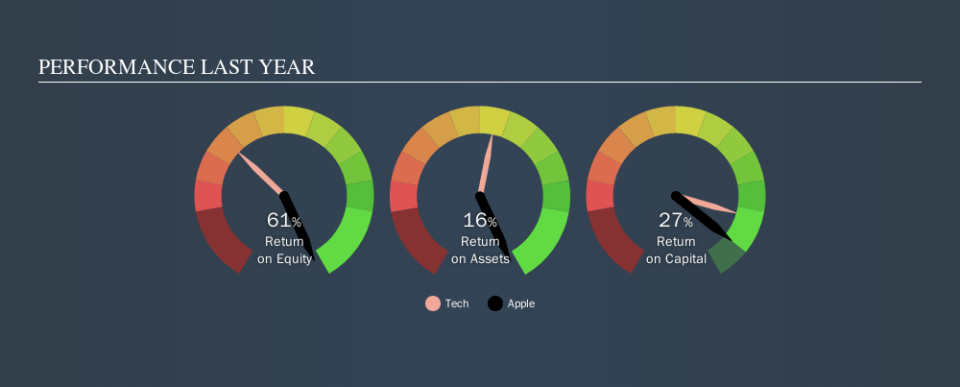Here's What Apple Inc.'s (NASDAQ:AAPL) ROCE Can Tell Us

Today we'll look at Apple Inc. (NASDAQ:AAPL) and reflect on its potential as an investment. In particular, we'll consider its Return On Capital Employed (ROCE), as that can give us insight into how profitably the company is able to employ capital in its business.
First of all, we'll work out how to calculate ROCE. Second, we'll look at its ROCE compared to similar companies. Finally, we'll look at how its current liabilities affect its ROCE.
Return On Capital Employed (ROCE): What is it?
ROCE is a measure of a company's yearly pre-tax profit (its return), relative to the capital employed in the business. Generally speaking a higher ROCE is better. Overall, it is a valuable metric that has its flaws. Author Edwin Whiting says to be careful when comparing the ROCE of different businesses, since 'No two businesses are exactly alike.
How Do You Calculate Return On Capital Employed?
The formula for calculating the return on capital employed is:
Return on Capital Employed = Earnings Before Interest and Tax (EBIT) ÷ (Total Assets - Current Liabilities)
Or for Apple:
0.27 = US$64b ÷ (US$339b - US$106b) (Based on the trailing twelve months to September 2019.)
Therefore, Apple has an ROCE of 27%.
See our latest analysis for Apple
Is Apple's ROCE Good?
When making comparisons between similar businesses, investors may find ROCE useful. In our analysis, Apple's ROCE is meaningfully higher than the 8.5% average in the Tech industry. We consider this a positive sign, because it suggests it uses capital more efficiently than similar companies. Setting aside the comparison to its industry for a moment, Apple's ROCE in absolute terms currently looks quite high.
You can click on the image below to see (in greater detail) how Apple's past growth compares to other companies.
When considering ROCE, bear in mind that it reflects the past and does not necessarily predict the future. ROCE can be deceptive for cyclical businesses, as returns can look incredible in boom times, and terribly low in downturns. ROCE is only a point-in-time measure. What happens in the future is pretty important for investors, so we have prepared a free report on analyst forecasts for Apple.
How Apple's Current Liabilities Impact Its ROCE
Current liabilities are short term bills and invoices that need to be paid in 12 months or less. The ROCE equation subtracts current liabilities from capital employed, so a company with a lot of current liabilities appears to have less capital employed, and a higher ROCE than otherwise. To counter this, investors can check if a company has high current liabilities relative to total assets.
Apple has total liabilities of US$106b and total assets of US$339b. As a result, its current liabilities are equal to approximately 31% of its total assets. Apple's ROCE is boosted somewhat by its middling amount of current liabilities.
Our Take On Apple's ROCE
Still, it has a high ROCE, and may be an interesting prospect for further research. There might be better investments than Apple out there, but you will have to work hard to find them . These promising businesses with rapidly growing earnings might be right up your alley.
I will like Apple better if I see some big insider buys. While we wait, check out this free list of growing companies with considerable, recent, insider buying.
We aim to bring you long-term focused research analysis driven by fundamental data. Note that our analysis may not factor in the latest price-sensitive company announcements or qualitative material.
If you spot an error that warrants correction, please contact the editor at editorial-team@simplywallst.com. This article by Simply Wall St is general in nature. It does not constitute a recommendation to buy or sell any stock, and does not take account of your objectives, or your financial situation. Simply Wall St has no position in the stocks mentioned. Thank you for reading.

 Yahoo Finance
Yahoo Finance 
